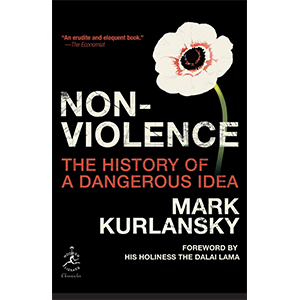Non-Violence: The History of a Dangerous Idea
The conventional history of nations, even continents, is a history of warfare. According to this view, all the important ideas and significant changes of humankind occured as part of an effort to win one violent, bloody conflict or another. This approach to history is only one of many examples of how societies promote warfare and glorify violence. But there have always been a few who have refused to fight. Governments have long regarded this minority as a danger to society and have imprisoned and abused them and encouraged their persecution.
This was true of those who refused Europe’s wars, who refused to fight for their king, who refused to fight for Napoleon as well as against him. It was true of Virginia Woolf’s sister Vanessa and her husband Clive Bell – outcasts in rural Sussex because they opposed World War I at a time when the British socialist movement described a bayonet as a weapon with a worker on each end.It was true of the first American draft dodger, a Menonite who believed in American independence but believed it was wrong to use violence and rejected the call of his local militia. It was true of the many abolitionists who had dedicated their lives to stopping slavery but refused to fight in the Civil War.
Judaism, Islam, Christianity, Hinduism, Buddhism and, most impressively, the Menonites and the Quakers – all have passages in their major teachings rejecting warfare as immoral. In this brilliant exploration of pacifism, these points of view are discussed alongside such diverse non-violence theorists as Tolstoy, Shelley, Gandhi, Martin Luther King, Aldous Huxley, Erasmus, Confucius and Lao Tse to show how many modern ideas – such as a united Europe, the United Nations, and the abolition of slavery – originated in such non-violence movements.
RM62.90
Out of stock
Description
The conventional history of nations, even continents, is a history of warfare. According to this view, all the important ideas and significant changes of humankind occured as part of an effort to win one violent, bloody conflict or another. This approach to history is only one of many examples of how societies promote warfare and glorify violence. But there have always been a few who have refused to fight. Governments have long regarded this minority as a danger to society and have imprisoned and abused them and encouraged their persecution.
This was true of those who refused Europe’s wars, who refused to fight for their king, who refused to fight for Napoleon as well as against him. It was true of Virginia Woolf’s sister Vanessa and her husband Clive Bell – outcasts in rural Sussex because they opposed World War I at a time when the British socialist movement described a bayonet as a weapon with a worker on each end.It was true of the first American draft dodger, a Menonite who believed in American independence but believed it was wrong to use violence and rejected the call of his local militia. It was true of the many abolitionists who had dedicated their lives to stopping slavery but refused to fight in the Civil War.
Judaism, Islam, Christianity, Hinduism, Buddhism and, most impressively, the Menonites and the Quakers – all have passages in their major teachings rejecting warfare as immoral. In this brilliant exploration of pacifism, these points of view are discussed alongside such diverse non-violence theorists as Tolstoy, Shelley, Gandhi, Martin Luther King, Aldous Huxley, Erasmus, Confucius and Lao Tse to show how many modern ideas – such as a united Europe, the United Nations, and the abolition of slavery – originated in such non-violence movements.
Publisher: Vintage
Paperback
2008
ISBN: 9780099494126






